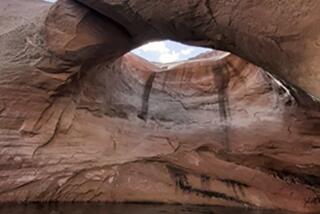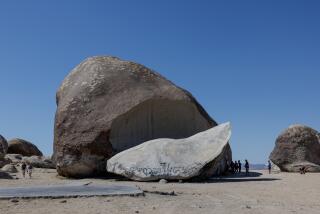The Old Man Tumbles, Taking His State’s Pride With Him
- Share via
BOSTON — The Old Man of the Mountain -- New Hampshire’s Great Stone Face -- fell Saturday, a tragedy of immense geological and cultural proportions in the Granite State.
“What other state has lost its symbol just like that?” said Marie Harris, the state’s poet laureate.
The four-story stone outcropping at Franconia Notch State Park in the White Mountains was reproduced on New Hampshire license plates, road signs and stationery. It’s on the commemorative-issue U.S. quarter. The landmark profile, trussed together for decades with cables and epoxy, collapsed into rubble after a brutalizing winter of high winds, heavy rains and freezing temperatures.
“There’s only so much you can do,” said state parks spokesman Mike Pelchat, who hiked up Saturday to make sure the beloved Old Man of the Mountain was not a victim of foul play. “We always thought it was the hand of God holding him up, and he let go.”
Thick clouds on Thursday and Friday obscured the top of Cannon Mountain, where the Old Man reposed, so state officials were uncertain just when he tumbled from the perch he assumed in the postglacial period of the last Ice Age, between 2,000 and 10,000 years ago. A state parks trail crew reported Saturday morning that the old stone man was gone.
A gasp of collective despair swept through the crowded annual meeting of the New Hampshire Historical Society in Concord when the Old Man’s collapse was announced Saturday morning.
“It was kind of like the life was sucked out of the room,” said Mark Foynes, the group’s education director. “The Old Man is a symbol of our identity, an exemplar of New Hampshire’s ruggedness -- both its terrain and what we like to think of as our character as people.”
Struggling for a parallel, Foynes said, “It would be as if someone snuck into the Grand Canyon at night with a gazillion tons of fill and filled the whole place up.”
The craggy stone profile was first sighted in 1805, as work crews carved a path for horses and ox carts through the White Mountains. As clouds lifted to reveal the distinctive profile formed by five granite ledges, the workers stopped in amazement.
Two of the workmen, Luke Brooks and Francis Whitcomb, both of nearby Franconia, reportedly gazed at the face-like stone configuration and said, “That is Jefferson!” -- president of the United States at the time.
Franklin Pierce, the only American president to hail from New Hampshire, loved to hike in the White Mountains -- known to many in the 19th century as “America’s Alps” -- and took his friend Nathaniel Hawthorne to see the Old Man. The novelist was so moved that he wrote a book, “The Great Stone Face,” using the landmark as an allegory for God.
“I’d say that through the mid-19th century the Old Man was seen very much as a Christ-like figure,” said Robert McGrath, a professor of art history at Dartmouth College in Hanover, N.H.
McGrath said the profile attracted painters and philosophers who pondered “the transcendental idea of God being present in the American landscape.”
The state even set aside kneeling places so the Old Man could be properly contemplated, he said, calling the landmark’s collapse “absolutely catastrophic.”
The profile prompted Daniel Webster to note that, while shoemakers hang signs shaped like shoes outside their businesses and dentists use depictions of teeth to advertise their trade, “Up in the mountains of New Hampshire, God Almighty has hung out a sign to show that there, He makes men.”
According to historian John T.B. Mudge, author of “The Old Man’s Reader,” there is no archeological or other evidence that the nomadic hunters who populated New Hampshire after the Ice Age knew about the stone formation.
The Old Man stood 1,200 feet above Profile Lake. His visage measured 25 feet across and 40 feet tall.
David Nielsen, whose late father was the profile’s official caretaker for decades, fought back tears Saturday as he gazed at the empty mountaintop.
“The oldest person in my family has just died,” he said.
For generations of Americans who came of age before mass airplane travel, the Old Man also was a road-trip destination.
New Hampshire regarded its geological landmark as an attraction comparable to Half Dome in Yosemite National Park.
Indeed, the geological composition of both natural monuments was similar.
But the Old Man often hid in the clouds, disappointing visitors who drove to see him. He also rested at an angle that sometimes challenged tourists.
“If you weren’t in the proper spot, you weren’t going to see him,” Foynes said.
On Friday night, for example, Dick Hamilton -- president of a tourism group called White Mountain Attractions -- drove through Franconia Notch State Park, as he has every day for more than 30 years, and spoke to the granite gentleman.
With the Old Man concealed by clouds, Hamilton said, “Good night, boss, wherever you are.”
On Saturday, Hamilton bemoaned: “I’ve just lost my No. 1 tourist attraction.”
Harris, the state’s poet laureate, said she recently published a children’s alphabet book called “G Is For Granite.”
The letter “O, of course, is for Old Man of the Mountain,” she said. “What do I do now, tell legions of schoolchildren to tear the page out? Or do I insist on a second printing with an elegy for the Old Man?”
Gov. Craig Benson, a Republican, announced Saturday that the face should be “revitalized.” Benson said he was meeting with state officials to discuss a plan.
“The Old Man is counting on us not to forget his legacy, and we won’t let him down,” Benson said.
But Dartmouth history professor Jerry Daniell said Saturday that “the thing has been falling apart for years. They had to hire people to shore it up.” Still, Daniell said, “The Old Man had a pretty good life.”
Visiting the Old Man on the 150th anniversary of the landmark’s first sighting, then-President Dwight Eisenhower was asked what he thought of the Old Man.
Eisenhower replied that a better question would be “what does he think of us?”
*
Associated Press contributed to this report.
More to Read
Sign up for Essential California
The most important California stories and recommendations in your inbox every morning.
You may occasionally receive promotional content from the Los Angeles Times.













